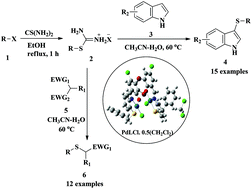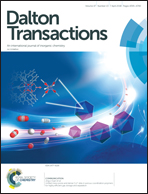Synthesis of a new series of Ni(ii), Cu(ii), Co(ii) and Pd(ii) complexes with an ONS donor Schiff base: crystal structure, DFT study and catalytic investigation of palladium and nickel complexes towards deacylative sulfenylation of active methylenes and regioselective 3-sulfenylation of indoles via thiouronium salt formation†
Abstract
A series of Ni(II), Cu(II), Co(II), and Pd(II) complexes have been synthesized with a chelating Schiff base ligand coordinated to a metal center with ONS donor atoms. The ligand and complexes are characterized by elemental analysis and spectroscopic techniques like FT-IR, 1H-NMR, and UV–Visible spectroscopy. The single crystal structure of the Pd(II) complex is obtained by X-ray diffraction analysis and exhibits slightly distorted square planar geometry. The structure is optimized by DFT, TD-DFT calculation to elaborate the electronic structure and NBO for the charge distribution analysis of the Pd(II) complex. The synthesized Pd(II) and Ni(II) complexes as catalysts have been investigated in the C–S cross-coupling of indoles and active methylenes. The metal propelled regioselective transformation afforded 3-sulfenylated indoles while β-diketones favored deacylated monosulfenyl ketones in an excellent yield via thiouronium salt formation. The Pd(II) complex displays slightly better reactivity whereas the Ni(II) complex is cost-efficient. The method is fast, easy to handle and cost effective in terms of high reactivity of catalysts, use of non-toxic solvents, and cheaper aryl halides and thiourea replace conventional sulfur sources, providing a practical access to organic transformations.



 Please wait while we load your content...
Please wait while we load your content...